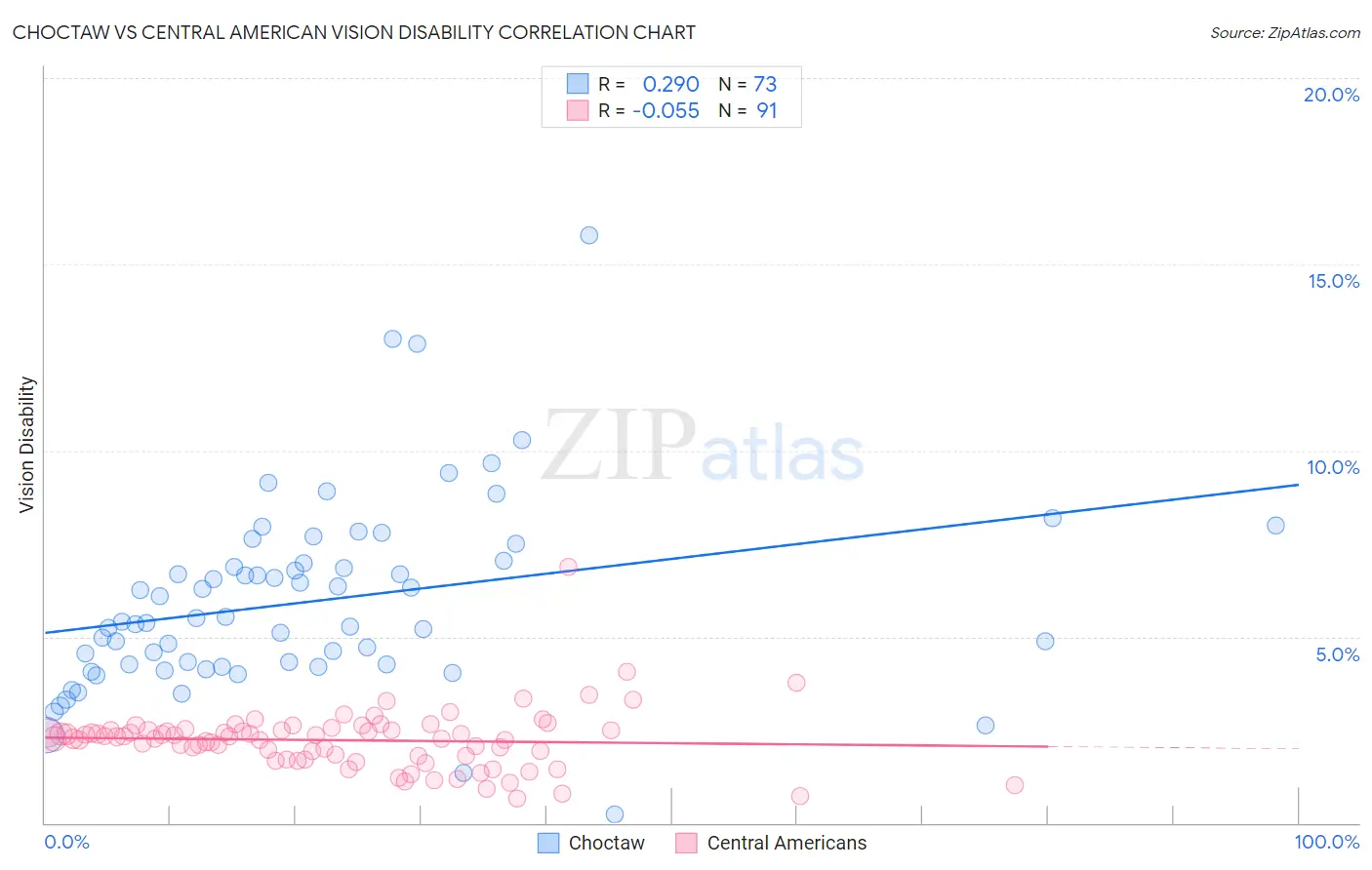Choctaw vs Central American Vision Disability
COMPARE
Choctaw
Central American
Vision Disability
Vision Disability Comparison
Choctaw
Central Americans
3.3%
VISION DISABILITY
0.0/ 100
METRIC RATING
342nd/ 347
METRIC RANK
2.3%
VISION DISABILITY
1.8/ 100
METRIC RATING
233rd/ 347
METRIC RANK
Choctaw vs Central American Vision Disability Correlation Chart
The statistical analysis conducted on geographies consisting of 269,580,756 people shows a weak positive correlation between the proportion of Choctaw and percentage of population with vision disability in the United States with a correlation coefficient (R) of 0.290 and weighted average of 3.3%. Similarly, the statistical analysis conducted on geographies consisting of 503,926,566 people shows a slight negative correlation between the proportion of Central Americans and percentage of population with vision disability in the United States with a correlation coefficient (R) of -0.055 and weighted average of 2.3%, a difference of 43.1%.

Vision Disability Correlation Summary
| Measurement | Choctaw | Central American |
| Minimum | 0.24% | 0.66% |
| Maximum | 15.8% | 6.9% |
| Range | 15.5% | 6.2% |
| Mean | 6.0% | 2.2% |
| Median | 5.4% | 2.3% |
| Interquartile 25% (IQ1) | 4.2% | 1.8% |
| Interquartile 75% (IQ3) | 7.0% | 2.5% |
| Interquartile Range (IQR) | 2.8% | 0.71% |
| Standard Deviation (Sample) | 2.6% | 0.81% |
| Standard Deviation (Population) | 2.6% | 0.81% |
Similar Demographics by Vision Disability
Demographics Similar to Choctaw by Vision Disability
In terms of vision disability, the demographic groups most similar to Choctaw are Pima (3.3%, a difference of 1.1%), Pueblo (3.3%, a difference of 1.1%), Kiowa (3.3%, a difference of 1.4%), Lumbee (3.4%, a difference of 2.7%), and Creek (3.2%, a difference of 2.8%).
| Demographics | Rating | Rank | Vision Disability |
| Cajuns | 0.0 /100 | #333 | Tragic 3.1% |
| Cheyenne | 0.0 /100 | #334 | Tragic 3.1% |
| Navajo | 0.0 /100 | #335 | Tragic 3.1% |
| Alaskan Athabascans | 0.0 /100 | #336 | Tragic 3.1% |
| Dutch West Indians | 0.0 /100 | #337 | Tragic 3.2% |
| Chickasaw | 0.0 /100 | #338 | Tragic 3.2% |
| Tsimshian | 0.0 /100 | #339 | Tragic 3.2% |
| Creek | 0.0 /100 | #340 | Tragic 3.2% |
| Kiowa | 0.0 /100 | #341 | Tragic 3.3% |
| Choctaw | 0.0 /100 | #342 | Tragic 3.3% |
| Pima | 0.0 /100 | #343 | Tragic 3.3% |
| Pueblo | 0.0 /100 | #344 | Tragic 3.3% |
| Lumbee | 0.0 /100 | #345 | Tragic 3.4% |
| Houma | 0.0 /100 | #346 | Tragic 3.4% |
| Puerto Ricans | 0.0 /100 | #347 | Tragic 3.9% |
Demographics Similar to Central Americans by Vision Disability
In terms of vision disability, the demographic groups most similar to Central Americans are German Russian (2.3%, a difference of 0.020%), Scottish (2.3%, a difference of 0.18%), Immigrants from Ecuador (2.3%, a difference of 0.20%), Marshallese (2.3%, a difference of 0.25%), and Immigrants from Congo (2.3%, a difference of 0.34%).
| Demographics | Rating | Rank | Vision Disability |
| Immigrants | Germany | 3.0 /100 | #226 | Tragic 2.3% |
| Hawaiians | 2.9 /100 | #227 | Tragic 2.3% |
| Hmong | 2.5 /100 | #228 | Tragic 2.3% |
| Welsh | 2.3 /100 | #229 | Tragic 2.3% |
| Nicaraguans | 2.2 /100 | #230 | Tragic 2.3% |
| Immigrants | Ecuador | 2.0 /100 | #231 | Tragic 2.3% |
| German Russians | 1.8 /100 | #232 | Tragic 2.3% |
| Central Americans | 1.8 /100 | #233 | Tragic 2.3% |
| Scottish | 1.6 /100 | #234 | Tragic 2.3% |
| Marshallese | 1.5 /100 | #235 | Tragic 2.3% |
| Immigrants | Congo | 1.4 /100 | #236 | Tragic 2.3% |
| Immigrants | Portugal | 1.4 /100 | #237 | Tragic 2.3% |
| Immigrants | Cambodia | 1.1 /100 | #238 | Tragic 2.3% |
| English | 1.1 /100 | #239 | Tragic 2.3% |
| Panamanians | 0.9 /100 | #240 | Tragic 2.3% |